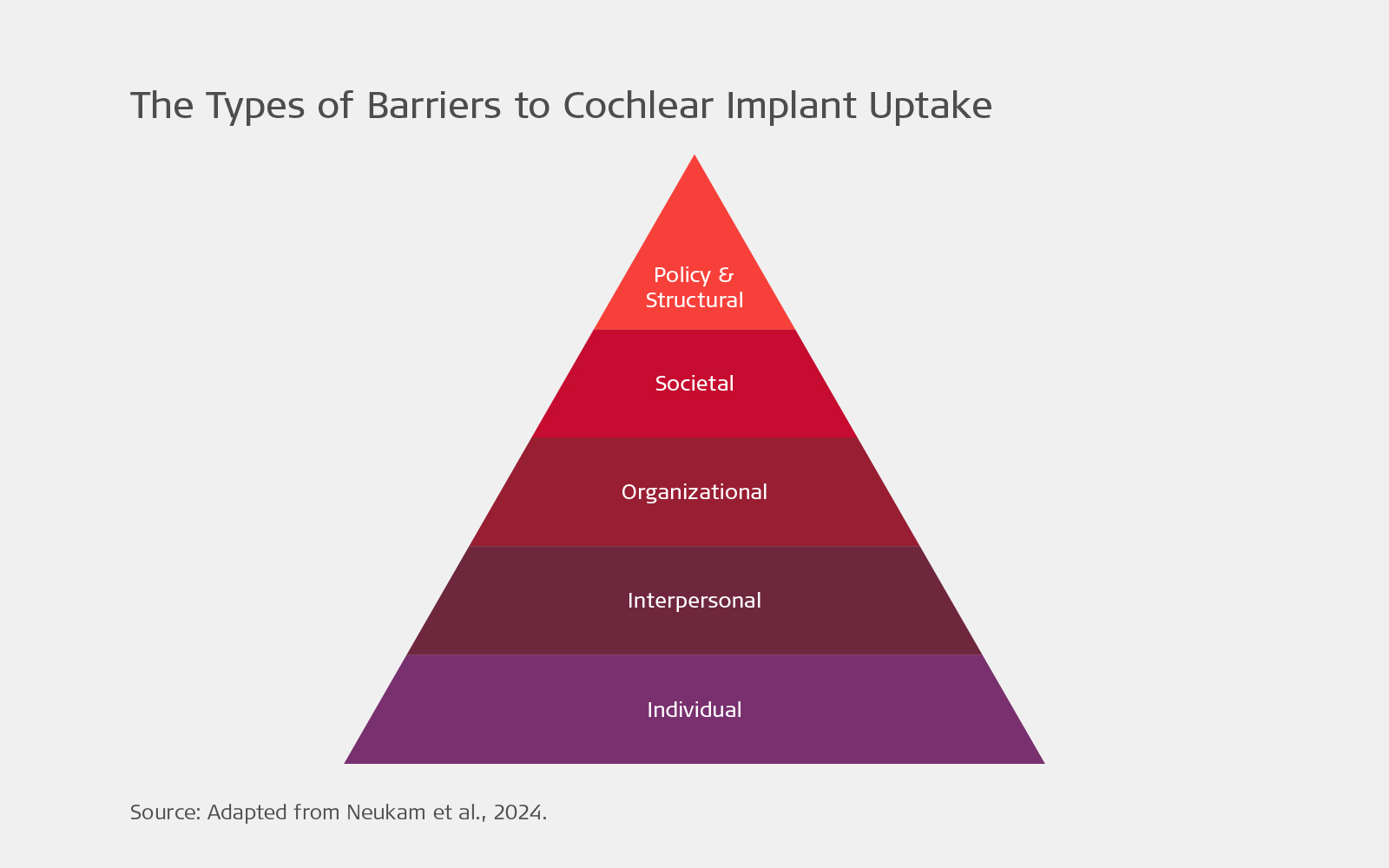
Nathan Schackow
Published Jun 23, 2025
Overcoming Barriers to Cochlear Implant Uptake in Older Adults
Lack of awareness, gradual hearing loss, and financial concerns are the most common barriers to cochlear implant uptake in older adults. Learn more about how hearing professionals can help overcome these obstacles to improve quality of life for cochlear implant candidates.

As hearing implant professionals, we experience the joy of watching older adult cochlear implant recipients regain their ability to communicate with friends and family members, independently attend medical appointments, and return to social gatherings.
Unfortunately, we also know that many older adults who are eligible for a cochlear implant do not get one. In fact, only about thirteen percent of candidates get implanted.Zeitler, D. M., Prentiss, S. M., Sydlowski, S. A., & Dunn, C. C. (2024). American Cochlear Implant Alliance Task Force: Recommendations for Determining Cochlear Implant Candidacy in Adults. The Laryngoscope, 134(S3), S1–S14. https://doi.org/10.1002/lary.30879[1]
Often, this is due to individual and interpersonal barriers. Read on for a closer look at the barriers to cochlear implantation, along with strategies to overcome some of the individual and interpersonal barriers.
- 1 The Most Common Barriers to Cochlear Implantation & Hearing Loss Treatment
- 2 Helping Patients Overcome Barriers to Hearing Loss Intervention
- 3 Age and Fear of Surgery
- 4 Perceived Sufficiency of Hearing Aid Performance
- 5 Uncertainty About Social Support
- 6 Uncertainty About Outcomes
- 7 Living Context
- 8 Logistics
- 9 Useful Resources
The Most Common Barriers to Cochlear Implantation & Hearing Loss Treatment

A recent MED-EL survey of over 10,000 adults in ten countries discovered that individuals often wait up to ten years before seeking a hearing assessment. The survey took a closer look at the reasons behind this delay to uncover the misconceptions and barriers that prevent timely action.
According to the survey, the top three reasons people delay hearing treatment are:
- Lack of awareness of the importance of regular hearing screenings and the available solutions
- Gradual hearing loss over time that makes recognizing the impact of hearing loss on daily life difficult
- Financial concerns about the costs associated with hearing treatments and devices
Other common barriers to addressing hearing loss include social perceptions of aging, access and availability of services, and social stigma.
The survey also showed that views on hearing loss shift as people age. Older adults (55 and up) struggle more to notice gradual hearing loss than young adults (18-24), and concerns about cost tend to increase with age. More details can be found in “The 10-Year Wait: What is Stopping People from Addressing Hearing Loss?”
The Types of Barriers to Cochlear Implant Uptake

Researchers from the Vanderbilt University Medical Center recently reviewed publications on the barriers to cochlear implant uptake in adults and grouped them into five categories: policy and structural, societal, organizational, interpersonal, and individual barriers.Neukam, J. D., Kunnath, A. J., Patro, A., Gifford, R. H., Haynes, D. S., Moberly, A. C., & Tamati, T. N. (2024). Barriers to Cochlear Implant Uptake in Adults: A Scoping Review. Otology & Neurotology, 45(10), e679–e686. https://doi.org/10.1097/mao.0000000000004340[2] The remainder of this article will dive into strategies to overcome some individual and interpersonal barriers identified.





Helping Patients Overcome Barriers to Cochlear Implantation & Hearing Loss Intervention
“These barriers are real, but they are not insurmountable. Many people mistakenly believe hearing loss is just a normal part of aging or something they can manage on their own. Others do not realize how deeply untreated hearing loss can affect their relationships, careers, and quality of life. Waiting not only worsens the condition—it robs people of valuable years where intervention could make a profound difference.”
Dr. Patrick D’Haese
Corporate Director of Awareness and Public Affairs at MED-EL
While policy and structural barriers are difficult for hearing implant professionals to tackle, others are less challenging, in particular, individual and interpersonal barriers. Here are some ways hearing professionals can help address many concerns and factors.
Age and Fear of Surgery
Some candidates are concerned that they are too old to receive a CI, often thinking that the surgery and recovery will be too much for them. They are right to have concerns—but a discussion with an anesthesiologist can be reassuring and help to decide if the individual candidate is able to undergo general anesthesia. In some cases, when anesthesiologic risk is elevated, local anesthesia is used.Walters, B., Gaskell, P., Muzaffar, J., Iftikhar, H., Monksfield, P., & Bance, M. (2022). Cochlear implantation under local anesthetic: A systematic review and meta‐analysis. Laryngoscope Investigative Otolaryngology, 7(1), 226–236. https://doi.org/10.1002/lio2.720[3]
Furthermore, research has shown that surgical complications are low and recovery is relatively easy.Chen, D. S., Clarrett, D. M., Li, L., Bowditch, S. P., Niparko, J. K., & Lin, F. R. (2013). Cochlear Implantation in Older Adults. Otology & Neurotology, 34(7), 1272–1277. https://doi.org/10.1097/mao.0b013e3182936bb2[4] Some older adults have dizziness after surgery, more so than younger adults,Chen, D. S., Clarrett, D. M., Li, L., Bowditch, S. P., Niparko, J. K., & Lin, F. R. (2013). Cochlear Implantation in Older Adults. Otology & Neurotology, 34(7), 1272–1277. https://doi.org/10.1097/mao.0b013e3182936bb2[4] so it is a good idea to stay with a family member or friend after surgery.
Perceived Sufficiency of Hearing Aid Performance & Hearing Loss Configuration
As cochlear implant candidacy criteria have expanded, it has become more difficult for individuals to judge whether they are candidates. Because TV shows and movies often portray CI recipients as unable to hear at all, many people do not realize they could benefit from a CI.
Recent CI recipients often have good residual hearing, especially in the low frequencies. Such a hearing loss configuration can lead individuals to think that their hearing loss is too good for a CI even though their speech understanding is insufficient.
However, hearing professionals are aware that anyone who is struggling to understand speech with their correctly-fitted hearing aids—even when sounds seem loud enough—should receive a CI candidacy evaluation. For some, an EAS system that combines acoustic amplification in the low frequencies with electrical stimulation in the high frequencies might be an ideal choice.
The Only Cochlear Implants Proven to Preserve Residual Hearing
MED-EL CIs are the only cochlear implants on the market FDA-approved for hearing preservation since MED-EL’s FLEX electrode design allows the majority of recipients to retain some functional natural hearing post-implantation.US Food & Drug Administration. (2024). Premarket Approval, MED-EL Cochlear Implant System. P000025/S129. https://www.accessdata.fda.gov/cdrh_docs/pdf/P000025S129B.pdf[5]
This means MED-EL FLEX electrode arrays provide the best opportunity to preserve residual hearing for these patients, and that the majority of MED-EL recipients with FLEX electrodes can continue to enjoy their residual hearing and gain the benefits from hearing with a cochlear implant.US Food & Drug Administration. (2024). Premarket Approval, MED-EL Cochlear Implant System. P000025/S129. https://www.accessdata.fda.gov/cdrh_docs/pdf/P000025S129B.pdf[5]Heyning, P. H. V. de, Dazert, S., Gavilan, J., Lassaletta, L., Lorens, A., Rajan, G. P., Skarzynski, H., Skarzynski, P. H., Tavora-Vieira, D., Topsakal, V., Usami, S., Rompaey, V. V., Weiss, N. M., & Polak, M. (2022). Systematic Literature Review of Hearing Preservation Rates in Cochlear Implantation Associated With Medium- and Longer-Length Flexible Lateral Wall Electrode Arrays. Frontiers in Surgery, 9, 893839. https://doi.org/10.3389/fsurg.2022.893839[6]
Uncertainty About Social Support and Lack of Community
Both cochlear implant recipients and candidates can be unaware or lack access to social support and community.
Communities like Hearpeers are ideal for CI candidates to help address this concern. The platform offers ways to connect with current CI recipients, many of whom are older adults. Connecting with a current CI recipient can be an excellent way to gain insight into the cochlear implant process, from candidacy to rehabilitation.
What’s exciting about Hearpeers is that members can discuss CI topics with each other, find out about the latest MED-EL news and events, and learn about tips and tricks for living with a CI.
Support for the Hearing Implant Journey
Trained volunteers share their firsthand experience with hearing implant candidates and answer non-medical questions about life with a hearing implant.
Connect With HearpeersUncertainty About Outcomes
Uncertainty regarding the outcomes of a cochlear implant is an understandable concern for CI candidates. The blog Will I Regret Getting a Cochlear Implant? addresses many of the concerns older adults face before getting a cochlear implant.
Studies show that older cochlear implant recipients enjoy improved communication with others via enhanced speech recognition in quiet and in noise.Távora-Vieira, D., Wedekind, A., Acharya, A., Kuthubutheen, J., Voola, M., Cavalheri, V., & Friedland, P. (2025). Advanced age is not a predictor for cochlear implantation outcomes in adults with moderate to profound sensorineural hearing loss. Brazilian Journal of Otorhinolaryngology, 91(3), 101571. https://doi.org/10.1016/j.bjorl.2025.101571[7] It is true that some older adults might have a slower trajectory to reach their maximum performance Dillon, M. T., Buss, E., Adunka, M. C., King, E. R., Pillsbury, H. C., Adunka, O. F., & Buchman, C. A. (2013). Long-term Speech Perception in Elderly Cochlear Implant Users. JAMA Otolaryngology–Head & Neck Surgery, 139(3), 279–283. https://doi.org/10.1001/jamaoto.2013.1814[8] and slightly poorer communication abilities in noise, though it is important to note that older adults with normal hearing also have difficulties listening in noise.Weissgerber, T., Müller, C., Stöver, T., & Baumann, U. (2022). Age Differences in Speech Perception in Noise and Sound Localization in Individuals With Subjective Normal Hearing. Frontiers in Psychology, 13, 845285. https://doi.org/10.3389/fpsyg.2022.845285[9]
MED-EL offers many rehabilitation materials to achieve better performance faster with a cochlear implant.
Living Context
Retirement and nursing homes can provide their own challenges because staff are often not familiar with cochlear implants. Many have audiologists who visit the facilities from time to time or upon request, though often they are not familiar with CI products and their maintenance. CI professionals can contact the facility’s director to work with the audiologist in developing a plan to support CI candidates and recipients. In-service trainings can also be helpful.
Logistics
Some candidates have concerns about getting to the clinic for programming and follow-up appointments. This is especially true for those living in rural areas who might not drive as often as they did when they were younger. Often senior centers or community centers as well as religious organizations can arrange rides to medical appointments for older adults upon request if friends and family members are not available.
Now Remote Care is becoming more common. MED-EL offers audiologists the opportunity to adjust and send audio processor fitting maps via MAESTRO 10 or later and the HearCare MED-EL app.
On a more macro scale, the WHO’s World Report on Hearing was developed to promote global action for access to ear and hearing care across the world. It mentions countless ways to overcome barriers to hearing loss treatment at all levels.
“In many countries, treatments such as hearing aids and implants are either fully or partially funded by healthcare systems, yet people may not realize these options are readily available to them. Early intervention is not just about prevention—it transforms lives by keeping people connected, safeguarding mental well-being, and significantly enhancing quality of life.”
Dr. Patrick D’Haese
Corporate Director of Awareness and Public Affairs at MED-EL
Useful Resources to Overcome Barriers to Hearing Loss Treatment
- Vera’s Journey: An in-depth video series following an older adult through her cochlear implant journey.
- The Importance of Rehab for Older CI Recipients: Blog article focused on older adults
- Auditory Wellness in Active Aging: Article on the rising prevalence of age-related hearing loss and opportunities for hearing care professionals across the world
- Hearing Loss and Dementia: Exploring the relationship between cognitive decline and the loss of hearing
- Can Older Adults Benefit From Cochlear Implants?: Blog article written for cochlear implant candidates
If you have your own ideas about CI barriers and methods to resolve them, please let us know by commenting below.
Otherwise, don’t forget to share this with someone who might like it and subscribe to the MED-EL Professionals Blog if you haven’t already.
References
-
[1]
Zeitler, D. M., Prentiss, S. M., Sydlowski, S. A., & Dunn, C. C. (2024). American Cochlear Implant Alliance Task Force: Recommendations for Determining Cochlear Implant Candidacy in Adults. The Laryngoscope, 134(S3), S1–S14. https://doi.org/10.1002/lary.30879
-
[2]
Neukam, J. D., Kunnath, A. J., Patro, A., Gifford, R. H., Haynes, D. S., Moberly, A. C., & Tamati, T. N. (2024). Barriers to Cochlear Implant Uptake in Adults: A Scoping Review. Otology & Neurotology, 45(10), e679–e686. https://doi.org/10.1097/mao.0000000000004340
-
[3]
Walters, B., Gaskell, P., Muzaffar, J., Iftikhar, H., Monksfield, P., & Bance, M. (2022). Cochlear implantation under local anesthetic: A systematic review and meta‐analysis. Laryngoscope Investigative Otolaryngology, 7(1), 226–236. https://doi.org/10.1002/lio2.720
-
[4]
Chen, D. S., Clarrett, D. M., Li, L., Bowditch, S. P., Niparko, J. K., & Lin, F. R. (2013). Cochlear Implantation in Older Adults. Otology & Neurotology, 34(7), 1272–1277. https://doi.org/10.1097/mao.0b013e3182936bb2
-
[5]
US Food & Drug Administration. (2024). Premarket Approval, MED-EL Cochlear Implant System. P000025/S129. https://www.accessdata.fda.gov/cdrh_docs/pdf/P000025S129B.pdf
-
[6]
Heyning, P. H. V. de, Dazert, S., Gavilan, J., Lassaletta, L., Lorens, A., Rajan, G. P., Skarzynski, H., Skarzynski, P. H., Tavora-Vieira, D., Topsakal, V., Usami, S., Rompaey, V. V., Weiss, N. M., & Polak, M. (2022). Systematic Literature Review of Hearing Preservation Rates in Cochlear Implantation Associated With Medium- and Longer-Length Flexible Lateral Wall Electrode Arrays. Frontiers in Surgery, 9, 893839. https://doi.org/10.3389/fsurg.2022.893839
-
[7]
Távora-Vieira, D., Wedekind, A., Acharya, A., Kuthubutheen, J., Voola, M., Cavalheri, V., & Friedland, P. (2025). Advanced age is not a predictor for cochlear implantation outcomes in adults with moderate to profound sensorineural hearing loss. Brazilian Journal of Otorhinolaryngology, 91(3), 101571. https://doi.org/10.1016/j.bjorl.2025.101571
-
[8]
Dillon, M. T., Buss, E., Adunka, M. C., King, E. R., Pillsbury, H. C., Adunka, O. F., & Buchman, C. A. (2013). Long-term Speech Perception in Elderly Cochlear Implant Users. JAMA Otolaryngology–Head & Neck Surgery, 139(3), 279–283. https://doi.org/10.1001/jamaoto.2013.1814
-
[9]
Weissgerber, T., Müller, C., Stöver, T., & Baumann, U. (2022). Age Differences in Speech Perception in Noise and Sound Localization in Individuals With Subjective Normal Hearing. Frontiers in Psychology, 13, 845285. https://doi.org/10.3389/fpsyg.2022.845285
References

Nathan Schackow
Was this article helpful?
Thanks for your feedback.
Sign up for newsletter below for more.
Thanks for your feedback.
Please leave your message below.
CTA Form Success Message
Send us a message
Field is required
John Doe
Field is required
name@mail.com
Field is required
What do you think?
The content on this website is for general informational purposes only and should not be taken as medical advice. Please contact your doctor or hearing specialist to learn what type of hearing solution is suitable for your specific needs. Not all products, features, or indications shown are approved in all countries.

Nathan Schackow



